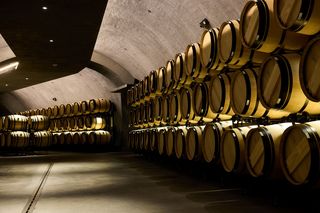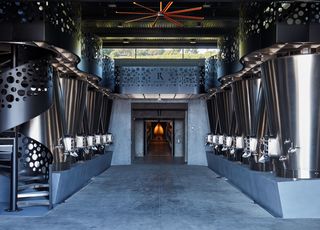Benoit: “Replanting the SLD Estate Vineyard means more than changing out rootstocks and clones. We’re looking at transforming the landscape. It’s an opportunity to completely reimagine what this site can be. We’re exploring all the avenues and trying to ask all the right questions.”
When we acquired our Stags Leap District Estate in late 2015 we understood the vineyard would need to be replanted. Benoit has worked with the site since 2004, and knew the age of the vines was showing. They’d been planted in the mid-1990s, after phylloxera had destroyed many vineyards in Napa Valley. But so much has changed in viticulture since then, major advances in clones, rootstocks, trellising, sustainability and more. There are new farming technologies that would have been unimaginable in the 1990s. Replanting would give us the opportunity to put all this knowledge and technology into practice.
But we couldn’t do it all at once. For one thing, it would have meant interrupting the production of Moonracer for several years, something we weren’t willing to risk. In 2016 we tore out two blocks comprising three acres of vines sitting up behind the winery. At that point they were the highest elevation blocks on the Estate, but they were also the lowest performing. After amending the volcanic soil, we planted rootstock in 2016, grafted the clonal material in 2017, and should have our first grapes from these blocks in 2021. We may get a little fruit in 2020, but it will take some time for the vines to establish themselves.
We’ve also implemented changes in terms of pruning, irrigation management and canopy management, but we’re not rushing anything. Benoit has always believed that with the right approach, this property could be one of the finest vineyards in Napa Valley, and certainly one of the great Estates in the Stags Leap District. He’s probably dug around 50 backhoe pits here, excavating down through layers of soil and rock material to study and understand the composition and chemistry. Between his knowledge and experience with the site and the time we’ve spent in the last five years to gain even more understanding, a concept of how to transform this property has come into focus.
Scott: “We’re not trying to be cowboys who show up on a Cat D9 and start bulldozing. There was a lot of that in the 1980s with some not-so-great results, and as an industry we learned from that. But we do intend to re-contour the land in places. We’re trying to be thoughtful about it. We’ve studied the soils in the vein where our new caves will go, pulling material out from the interior of the hillside. We’ve analyzed that material and no surprise, it’s rocky and well-draining. So rather than trucking it away, we’ve decided to add it to some of the existing contours and slopes of the property. For instance, we have a little more clay content down near the front gate; those soils are a little deeper and richer. The soils we’re pulling out of the hillside will give that area much better drainage. Mixing it in will only be additive.”
We’ve also introduced new technologies into the vineyard with plans to add more, including sustainable tools and practices around irrigation and water conservation. We’re looking at integrating organic and even biodynamic practices where it makes sense and increases quality. We’re taking into account what may happen as a result of climate change, developing an infrastructure that can help vines survive warmer growing seasons. We’ll have the ability to irrigate blocks independently at a moment’s notice, and we’re also designing a misting system for each block. But it doesn’t stop there.
Scott: “We’re looking at the vineyard not by acres or by blocks or even by rows, but down to individual vines. We want the ability to influence the microclimate right around the fruit cluster on any given day; at some point we'll be able to control the emitters on either side of an individual vine. There are 20 acres and 2,700 vines in an acre, so you can do the math, but that’s what we’re aiming for: farming in a very precise way but also at scale. I’ve always said we’re limited only by our own imaginations. Re-imagining Realm’s Estate SLD Vineyards is a once in a generation opportunity.”
It’s interesting, because until recently the aim of most vineyard managers was homogeneity: dividing a vineyard into blocks and farming them so that each block is uniform, ready to pick at the same time. But we're not just farming. We’re responsible for what ends up in the bottle. And from a winemaking standpoint, there's an argument to be made that within tolerance, a little bit of heterogeneity is a good thing because it adds complexity. Particularly with Cabernet, where we want a wine that’s rich, but also fresh. We don’t want green or unripe flavors, but we don’t necessarily want baked fruit either. So how do you dial back from either side but maintain that complexity? You farm vine by vine. It’s about specificity and incredible attention to detail. And it requires a level of vineyard design and infrastructure that may be unprecedented. Does it cost more and take longer? Yes, but if it leads to an increase in quality, even incrementally, we’re up for it. We believe this is the future of Napa Valley.
~
With the additional six acres acquired from the Hartwell Estate in 2020, Realm owns the entire eastern flank of Wappo Hill, twenty or so acres of vineyard that will eventually be laid out in approximately one-acre blocks. Much as we did five years ago, it is time to walk these hills, take our time and figure out the best potential of the land. It’s very much a work in progress. We probably have a decade of work ahead of us here.
Scott: “I remember many years ago meeting Bart Araujo when he still owned Eisele Vineyard. He talked about how Eisele had been there before him and would be there after him. It really struck me, that concept of stewardship, of the enduring nature of land. As we redevelop this Estate, we’re taking the long view. This is our generation’s chance to get it right.”




